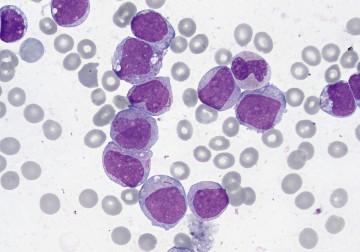In a new study from LVPEI, Dhwanee Agarwal and others explore how eye changes in leukemia patients can predict disease remission and vision outcomes.
Leukemia is a cancer of the blood and bone-marrow and can emerge in any part of the body. Yet, a detailed eye exam can offer one of the first diagnostic clues of this systemic cancer. Leukemia occurs in two major forms — acute (progresses quickly) and chronic (progresses slowly). Each of these is further divided based on the blood cell affected: lymphoid (a type of white blood cells that provide a specific, long-term immune response) or myeloid cells (a type of white blood cells that mount a quick and general immune response). In combination, leukemia is divided into four main subtypes — acute lymphoblastic leukemia (ALL), acute myeloid leukemia (AML), chronic myeloid leukemia (CML), and chronic lymphocytic leukemia (CLL). Leukemic cancerous cells infiltrate the eye in various forms, leaving key markers of this disease.
In fact, each leukemic subtype causes changes in the eye in different ways, and a varying degree of each subtype manifests as a cancer of the eye. Leukemia can also cause secondary infections or damage to the eye, and it requires some skill and expertise to separate out the various presenting signs to ultimately identify the leukemia. Specific changes to the eye, especially the retina, and the presence or absence of leukemic tissue in the eye are a reliable guide for disease prognosis, including relapse and remission. So, what ocular manifestations should warn a clinician about the onset of this cancer?
In a new retrospective study published in the British Journal of Ophthalmology Dhwanee Agarwal and colleagues from LVPEI examined data from 244 leukemia patients (378 eyes; mean age: 34 years) who presented at the hospital over a period of 8 years, to understand the cancer’s ocular manifestations. They found that the eye was most affected in patients with ALL (58%). More than half the patients (64%) showed changes in the posterior segment of the eye (retina and optic nerve). Retinal bleeding (hemorrhages) was more common in patients with myeloid leukemia, while lymphoid leukemia caused changes like a swelling of the optic disc. Interestingly, the study also saw that hemorrhagic changes were more frequent in chronic (CML) patients (44%) though it is usually associated with acute (AML) cases. It was also noted that CML affected the posterior part of the eye with non-hemorrhagic changes suggesting that CML affects the eye in various ways.
The findings also indicate that just having myeloid leukemia increases the chances of poor visual outcome irrespective of other factors. Two features seen in eye imaging — an epiretinal membrane (formation of a thin membrane over the retina) and submacular hemorrhage (bleeding beneath the central retina) were strongly linked to disease relapse and poor visual recovery. The study reported that most patients improved after chemotherapy, though a few had long-term changes like retinal scarring or optic nerve damage. The authors note that collaboration between eye specialists and oncologists can help in early detection, guiding treatment decisions to improve both visual and overall outcomes.
'This study can help predict subtypes of leukemia and treatment response by analyzing the clinical manifestations it presents with', notes Dr. Dhwanee Agarwal, ophthalmologist at LVPEI and first author of the study. 'Pattern recognition, especially presence of hemorrhagic features at the macula and epiretinal membrane has significant association with poor visual outcome.'
'Leukemic cancers of the blood are a relatively common form of this disease, and one of the first signs of this debilitating condition, including remission, can show up in an eye examination,' notes Dr Vishal Raval, consultant ophthalmologist at LVPEI, and the corresponding author of this paper. 'With this research, we are laying the ground for identifying ocular biomarkers that will help identify onset or remission of the different kinds of leukemia in patients.'
Citation
Agarwal D, Tyagi M, Pappuru RKR, Raval V. Ophthalmic manifestations and treatment outcomes in leukaemia: a comparative analysis of clinical spectrum, visual prognosis and predictors of disease remission across subtypes. Br J Ophthalmol. 2025 Aug 28:bjo-2025-327835. doi: 10.1136/bjo-2025-327835. Epub ahead of print. PMID: 40877022.
Photo credit: Acute Myelogenous Leukemia; Animalculist; CC BY 4.0



